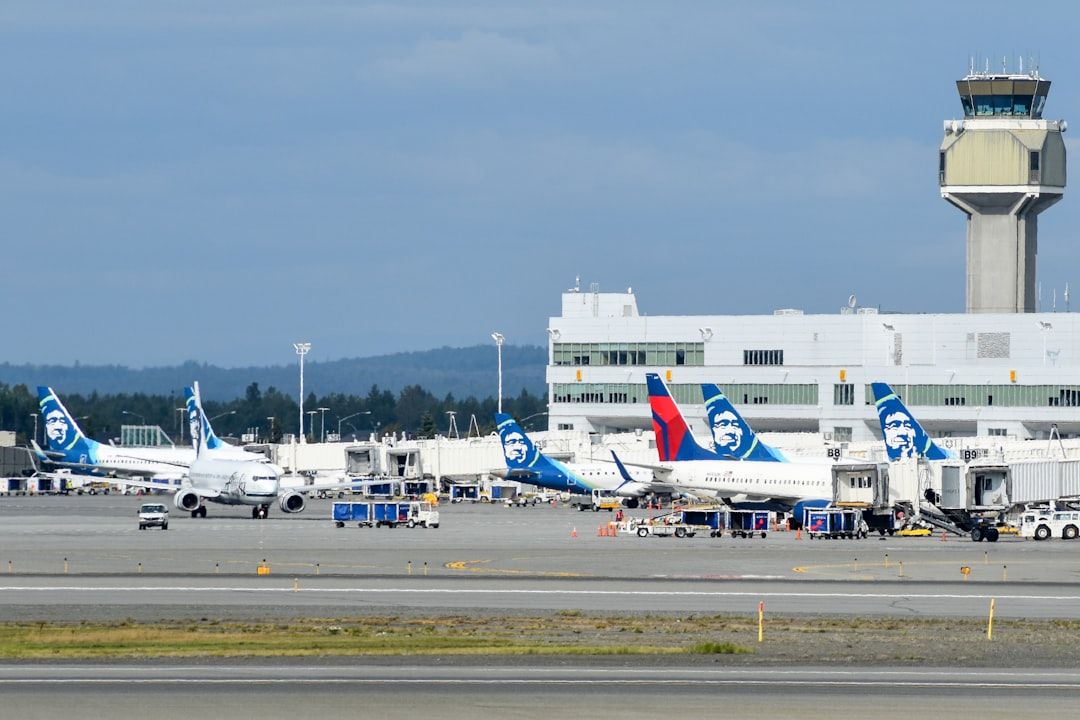Late on Sunday, July 20, 2025, Alaska Airlines requested a ground stop for all its mainline aircraft, according to the Federal Aviation Administration (FAA). This sudden move has left thousands of travelers across the United States 🇺🇸 and beyond facing delays and uncertainty, as the airline and regulators have not yet explained the reason for this major operational halt.
What Happened and Who Is Affected

The FAA confirmed that as of 11:09 PM Eastern Time, Alaska Airlines asked for a ground stop on all its mainline flights. This means that none of the airline’s mainline planes are allowed to take off from any airport until further notice. The ground stop affects all destinations served by Alaska Airlines’ mainline fleet, which covers most of its domestic and some international routes.
Passengers booked on these flights are directly impacted. Many have found their travel plans suddenly disrupted, with flights delayed or canceled. Alaska Airlines has not said how long the ground stop will last or when normal service will resume. The FAA’s status page remains the best source for real-time updates, but as of now, there is no clear answer for travelers waiting at airports or planning upcoming trips.
Why Was the Ground Stop Ordered?
As of the latest reports, neither Alaska Airlines nor the FAA has released an official statement explaining the cause of the ground stop. Both organizations did not respond to media requests for comment outside regular business hours. This lack of information has led to confusion and concern among passengers, airline staff, and industry observers.
A ground stop of this scale is rare and usually signals a serious issue—often related to safety, technical problems, or security concerns. However, without an official explanation, it is not possible to say exactly what prompted Alaska Airlines to make this request.
Background: Recent Safety Concerns and Regulatory Scrutiny
This event comes at a time when Alaska Airlines is already under close watch from regulators and the public. In January 2024, Alaska Airlines flight 1282 suffered a mid-flight door plug separation, an incident that drew national attention and led to a major investigation. The National Transportation Safety Board (NTSB) released its final report on July 10, 2025, blaming Boeing for poor training and oversight in its manufacturing process.
Since that incident, the FAA has increased its oversight of both Boeing and airlines operating Boeing aircraft, including Alaska Airlines. The agency has focused on making sure airlines follow strict safety and quality rules. While there is no official link between the current ground stop and the earlier Boeing 737-9 safety problems, the timing has raised questions among industry experts and travelers alike.
How the Ground Stop Works
A ground stop is an order that prevents aircraft from taking off. It can be requested by an airline or ordered by the FAA. Ground stops are used in situations where there is a risk to safety, a technical problem, or a security threat. They are not common, especially for a single airline’s entire mainline fleet.
In this case, Alaska Airlines itself requested the ground stop, and the FAA confirmed and enforced it. The order covers all mainline aircraft, which make up the majority of Alaska Airlines’ flights. Regional flights operated by partner carriers may not be affected, but this has not been confirmed in current reports.
Impact on Passengers and Communities
The most immediate effect is on passengers. People waiting to board Alaska Airlines mainline flights have seen their travel plans thrown into chaos. Some are stranded at airports, while others are trying to rebook or find out if their flights will depart at all. Families, business travelers, and tourists are all affected.
For many, the lack of information is especially frustrating. Without a clear reason for the ground stop or an estimate of when it will end, travelers are left to guess what will happen next. Alaska Airlines’ customer service channels and the FAA’s status page are the main sources of information, but updates have been limited so far.
The disruption also affects airport operations, as gates and runways become backed up with planes that cannot depart. Other airlines may see increased demand as passengers look for alternative ways to reach their destinations.
Operational and Industry Impact
Alaska Airlines is a major U.S. carrier, and its mainline fleet handles a large share of domestic and some international flights. A ground stop of this size has ripple effects across the airline industry. Other airlines may need to adjust their schedules or prepare for increased passenger loads. Airports served by Alaska Airlines will also need to manage the sudden change in traffic.
Industry experts say that ground stops are usually reserved for serious situations. The fact that Alaska Airlines requested the stop, rather than the FAA ordering it, suggests that the airline identified a problem that needed immediate attention. However, without more details, it is not possible to know if the issue is technical, safety-related, or something else.
Expert and Regulatory Analysis
Aviation experts point out that ground stops like this are very rare and usually mean something significant has happened or is suspected. The lack of an immediate explanation could mean that Alaska Airlines and the FAA are still investigating the situation or that they are dealing with a fast-changing problem.
Regulatory analysts note that the timing—just days after the NTSB released its final report on the 2024 door plug incident—may be a coincidence. Still, it highlights the increased attention on Alaska Airlines’ safety and operational practices. The FAA has been especially watchful of airlines operating Boeing aircraft since the 2024 incident.
As reported by VisaVerge.com, such events often lead to increased scrutiny not only of the airline involved but also of the broader industry, especially if the cause turns out to be related to aircraft manufacturing or maintenance.
What Should Passengers Do Now?
If you are booked on an Alaska Airlines mainline flight, here are some steps you can take:
- Check your flight status on the Alaska Airlines official website or through their customer service channels.
- Monitor the FAA status page for real-time updates on the ground stop and any changes to flight operations. You can access the FAA’s official status page here.
- Stay in contact with your departure airport for local updates and possible rebooking options.
- Consider alternative travel plans if your trip is urgent, but be aware that other airlines may also be experiencing higher demand due to the disruption.
For Media and Industry Observers
Journalists and industry professionals are advised to wait for official statements from Alaska Airlines and the FAA. Until more information is released, it is not possible to confirm the cause of the ground stop or predict when normal operations will resume.
Broader Implications for the Airline Industry
A ground stop of this size raises important questions for the entire airline industry. If the cause is related to a technical or safety issue with a specific type of aircraft, other airlines operating similar planes may also need to take action. If it is a security concern, the response could be even wider.
The event also puts a spotlight on the relationship between airlines, manufacturers like Boeing, and regulators such as the FAA and NTSB. After the 2024 Alaska Airlines incident, there has been a push for stricter oversight and better communication about safety and quality issues.
What Happens Next?
The most important next step is for Alaska Airlines or the FAA to release an official statement explaining the reason for the ground stop. This will help passengers, staff, and the public understand what happened and what to expect.
Depending on the cause, the ground stop could be lifted quickly, or it could last for several hours or even longer. If the issue is technical or safety-related, the airline and regulators will need to make sure it is fully resolved before flights can resume.
Possible Scenarios
While there is no official information yet, here are some possible reasons why an airline might request a ground stop:
- Technical Issue: A problem with a specific aircraft type or system that affects safety.
- Safety Concern: Discovery of a risk that needs to be checked before flights can continue.
- Security Threat: A credible threat that requires immediate action.
- Operational Problem: Issues with airline systems, such as computer outages or communication failures.
Until Alaska Airlines or the FAA provides more details, these remain only possibilities.
Advice for Affected Communities
Communities served by Alaska Airlines may see increased travel disruptions, especially in areas where the airline is the main carrier. Local businesses, tourism operators, and families expecting visitors could all feel the impact.
Airports should prepare for higher numbers of stranded passengers and increased demand for customer service. Other airlines may also need to adjust their operations to handle extra travelers.
Official Resources and Where to Get Help
For the latest updates and official information, use these resources:
- Alaska Airlines Customer Service: Visit the Alaska Airlines website or call their customer support line for flight status and rebooking options.
- FAA Status Page: Check the FAA’s official site for real-time updates on the ground stop and other operational notices.
- NTSB Reports: For background on recent safety investigations, visit the NTSB official website.
Looking Ahead: What to Watch For
Travelers, industry professionals, and the public should watch for:
- Official statements from Alaska Airlines and the FAA explaining the cause and expected duration of the ground stop.
- Updates on flight operations as the situation develops.
- Possible impacts on other airlines if the issue is found to affect more than just Alaska Airlines.
- Regulatory actions if the ground stop leads to broader safety or operational changes.
Conclusion and Practical Takeaways
The Alaska Airlines ground stop ordered on July 20, 2025, is a major event with wide-reaching effects. Passengers should stay informed through official channels and be prepared for delays or changes to their travel plans. The FAA and Alaska Airlines are the best sources for real-time updates and official explanations.
Until more information is available, the best advice is to remain patient, check for updates often, and consider alternative travel options if needed. This event also serves as a reminder of the importance of strong safety oversight and clear communication in the airline industry.
As the situation develops, continue to monitor official sources for the latest news and guidance. The FAA’s status page remains the most reliable place for real-time operational updates, and Alaska Airlines’ customer service can help with specific travel questions. For background on airline safety investigations, the NTSB website offers detailed reports and findings.
Stay tuned for further updates as more information becomes available about the cause and resolution of the Alaska Airlines ground stop.
Learn Today
Ground Stop → An order preventing aircraft from taking off, used for safety, technical, or security issues.
Mainline Flights → Primary routes operated directly by Alaska Airlines’ main fleet covering domestic and international destinations.
FAA → Federal Aviation Administration, the U.S. agency regulating civil aviation and enforcing safety standards.
NTSB → National Transportation Safety Board; investigates transportation incidents and provides safety recommendations.
Boeing 737-9 → A model of Boeing’s aircraft involved in a 2024 safety incident impacting Alaska Airlines flights.
This Article in a Nutshell
On July 20, 2025, Alaska Airlines halted all mainline flights via a ground stop, causing nationwide delays and uncertainty without official cause, amidst increased scrutiny following a 2024 safety incident involving Boeing aircraft.
— By VisaVerge.com












